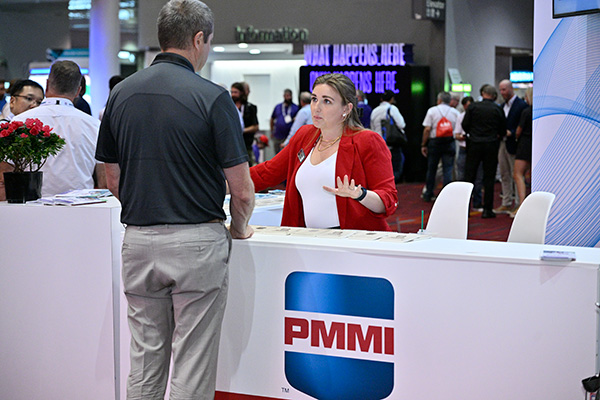While delivery of spare parts is essential to end users, OEMs can now predict customers’ future parts needs through the latest technologies.

by Tom Egan, Vice President of Industry Services, PMMI
Original equipment suppliers (OEMs) continue to obtain most of their revenue from machine sales. In the last decade, however, OEMs and their supplier partners have been focusing more on aftermarket portfolios to establish ongoing revenue streams, according to a recent aftermarket industry report from PMMI, The Association for Packaging and Processing Technologies.
Consequently, in today’s competitive environment, OEMs and their supplier partners must carefully evaluate their sales and service strategies to ensure their aftermarket capabilities are robust enough to meet end-users’ needs.
That means it is essential for OEMs and their supplier partners to fulfill end-users’ requests regarding digital and remote connectivity, documentation, communication channels, warranties, and aftermarket contracts, according to PMMI’s 2025 Aftermarket Parts & Services study. But each end user has different needs and capabilities, so OEMs and their supplier partners must offer aftermarket parts and services in the format, timeframe, and level of sophistication that matches each of them.
For end users, availability is the priority for standard wear parts (common, standardized offerings). They most commonly turn to OEMs, but are often willing to look elsewhere to obtain a part more quickly.
Most end users keep an in-house inventory of both standard wear parts (62%) and critical parts (72%). However, there is a broader gap when sourcing these parts. More end users (77%) purchase critical parts from OEMs, while only 41% buy standard spare parts from them.
Therefore, critical wear parts are an important area where OEMs can solidify their strongest position as trusted providers. Of course, to make the most of this opportunity, OEMs must have accurate and readily available inventory.
Artificial intelligence (AI) is a major trend across all industries, and manufacturing is no exception. From predictive models to machine learning, AI is a powerful tool to drive manufacturing efficiency.
In some instances, OEMs are deploying generative AI programs to help them sort, organize, and better leverage their operational and sales data. For example, some OEMs are deploying generative AI models to process, sort, clean, and organize operation-wide data, analyzing sales patterns, parts and service requests, outcomes, and retention, allowing them to leverage their operational and sales data.
This is important since OEMs are relying on big data more than ever to uncover new opportunities and identify gaps in their business. One way to leverage big data in the aftermarket is to analyze purchase patterns to understand which parts and/or services are commonly purchased together and then offer bundled deals.
Using this same data, OEMs also can begin to map how the purchase of one part is likely to indicate the purchase of another. This approach can reveal connections that are not always obvious. For example, while parts X and Y may often be purchased together, the data might also show that customers frequently buy part Z at the same time, despite no clear link. Understanding these patterns can uncover significant opportunities for additional sales and upselling.
With these insights, OEMs can bundle parts and service offerings into comprehensive packages that reduce costs, enhance competitiveness, and provide meaningful savings for customers. These bundled deals also save end users time and effort by simplifying ordering decisions, making the deals doubly attractive to resource-limited end-user operations.
Across the board, end users report strong budgets for aftermarket parts. As end users continue to focus on improving the uptime efficiency and lifecycles of their current machinery, 43% predict spending more on aftermarket parts compared to 2024. Additionally, over half of end users are planning to maintain their current spend on aftermarket parts in 2025. In other words, 98% of end users expect their budgets for aftermarket parts to either expand or remain the same this year.
As with aftermarket parts, end users project budgets to go unchanged or increase for aftermarket services in 2025. A little over a third of end users (34%) predict their budgets for aftermarket services will grow this year, while an additional 60% indicate they will be spending the same on aftermarket services in 2025 as they did in 2024.
These predictions align with manufacturing industry trends, according to PMMI’s report. With tight budgets, economic uncertainty, labor shortages, and ongoing supply issues, end users are increasingly focusing on maximizing the performance of existing machinery. Rather than pursuing capital-intensive investments in new machinery, end users are doubling down on improvement strategies to existing assets to expand capacity and efficiency.
OEMs and end users agree that the top challenges are meeting delivery and lead time expectations and having the right technician at the right time to service new and legacy machinery. Thus, collaborative communication between end users and OEMs is crucial.
To establish a stronger relationship with each end user, OEMs and their supplier partners should:
PACK EXPO Las Vegas, scheduled for Sept. 29 to Oct. 1, 2025, at the Las Vegas Convention Center, is the premier event for the packaging and processing industry. This biennial event, produced by PMMI, The Association for Packaging and Processing Technologies, is renowned for showcasing cutting-edge innovations and facilitating invaluable networking opportunities.

About the Author:
Tom Egan is vice president of Industry Services for PMMI, the Association for Packaging and Processing Technologies.
Scott Ellyson, CEO of East West Manufacturing, brings decades of global manufacturing and supply chain leadership to the conversation. In this episode, he shares practical insights on scaling operations, navigating complexity, and building resilient manufacturing networks in an increasingly connected world.